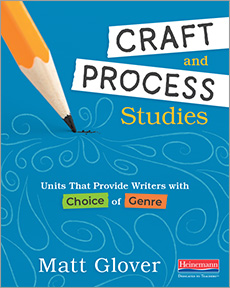Providing Our Writers with Genre Choices
Craft and Process Studies: Units That Provide Writers with Choice of Genre
By Matt Glover
(Heinemann, 2020 – Learn more)

A short story unit, then poetry, perhaps a drama, non-fiction. If you are like many teachers (myself included), this is how you arrange your reading and writing units, but genre study isn’t the only way to mold young writers.
In fact, in Craft and Process Studies: Units That Provide Writers with Choice of Genre, author Matt Glover pushes the idea that process and craft studies are not only something we should add to our curriculum, but that they are equally as important as the genre studies we are so used to teaching.
I found myself drawn to the phrase “choice of genre” in the title. I’m looking to add more student autonomy to my instruction.

Although this book is most suited to the late elementary grades, I found several units I could adapt for my middle schoolers, and I would’ve loved to have had it as a guide when I was teaching fourth and fifth graders.
Why genre choice matters
Part One of the book starts out with the why of letting – actually encouraging – students to write in their choice of genre and experiment with the process and the format instead of forcing them to write in a prescribed format.
Glover makes a compelling case for letting student choice guide teacher decisions in writing instruction, leading to more student engagement and, for the teacher, the ability to hone down teaching to target specific abilities that can be used across genres.
The vignettes he provides are truly enlightening. Many of our students do write on their own, but perhaps not in the forms we choose for them in the school setting. We may be killing the love of writing for some students by failing to recognize their writing lives outside school.
This book illuminated for me that by denying them that choice and not purposefully letting students see the myriad ways and formats authors choose to share their ideas, we are limiting ourselves and our connections with our students as well.
Bringing craft and process to student writing
So I was sold on the ideas presented in the first chapter. Glover goes on to explain more deeply exactly what it means to teach craft and process and how to integrate those units with what may be the required genre studies in your district.
I appreciate that Glover is a realist and knows most teachers don’t have complete say over what or how they teach. Providing a workable template for shortening required units to add craft and process segments between genre studies is part of what makes this book so teacher-friendly.
Glover also identifies how to set and clarify goals for teaching and how to confer with and evaluate student work for each type of unit. For example, in genre teaching students craft a piece of writing in the genre to show their understanding. In craft studies they exhibit a particular concept in whichever genre they choose, and process study can be seen in drafts, plans, and student comments.
Getting specific
Without being prescriptive in Part Two of Craft and Process Studies, the author lays out specific unit ideas and how those might be developed. Each chapter contains ideas for unit name, rationale, appropriate grade-level range and time of year for teaching, outcome and celebration ideas, unit questions, teaching and conferring ideas, and more resources on teaching that type of unit.
The range of options in the “Possible Teaching Points” and “Conferring” points were by far the most helpful to me in envisioning how I could make the switch from genre-based units. I also appreciated the easy-to-recognize reminder boxes with ideas from Part One of the book included at key points in Part Two so I didn’t have to flip back and forth.
My key takeaways from this book surrounded this idea: “Without the ability and opportunity to find authentic writing projects, it will be more difficult for them to become truly self-directed” (8). If we don’t let students choose, they won’t know what they like and are good at as writers. If we don’t let them choose, they “won’t have experience in choosing genres to match an audience and purpose” (8).
Although genre study still has its place (in my state standardized testing mandates that students know and can write in specific modes), we can guide student writing without forcing them to write in those modes all the time.
In fact, this book allowed me to see that teaching some standards will be much better served with a process or craft unit than a genre unit as students make connections between and among pieces of writing across genres.
Starting the year with choice
As I continue my planning for the coming year, I look forward to having my students write in different genres while we work on peer conferencing or planning strategies or word choice or using punctuation as a crafting tool. Starting out the year by offering choice of genre, as Glover suggests, will allow me to get to know my students as people and writers much better than my standard personal narrative unit.
I thank Matt Glover and his book Craft and Process Studies: Units That Provide Writers with Choice of Genre for giving me ideas for units where students can have options and feel empowered, while teachers still focus on building writing skills and stamina.
Rebecca Crockett currently teaches seventh and ninth grade English and reading in north central Idaho. A thirteen-year teaching veteran, she has taught at both the elementary and secondary levels. She is an avid reader, curriculum planner, and sometimes writer for her own enjoyment and to practice what she preaches. Since 2013, she has been part of the Idaho Coaching Network whose focus is providing professional development and improving teacher practice.


































